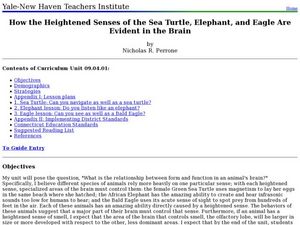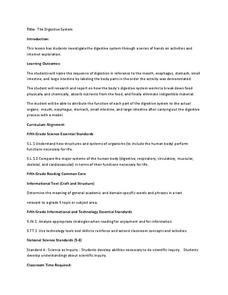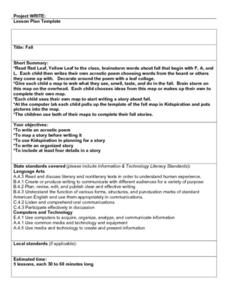Scholastic
The Science of Marijuana—How THC Affects the Brain
Marijuana can affect every part of a user's life—starting with the delicate nervous centers of the brain. An informative article and worksheet prompt teenagers to learn more about how the THC found in most forms of marijuana can...
Curated OER
Structure of the Nephron
In this nephron learning exercise, students color the parts of the nephron and answer five questions about the structures and functions of the parts of the nephron.
Curated OER
Brain Awareness Week
Middle schoolers explore human anatomy by completing a list of activities over five days. In this brain science lessons, students examine images of brains and identify the different parts. Middle schoolers complete an in-class quiz...
Curated OER
How the Heightened Senses of the Sea Turtle, Elephant, and Eagle Are Evident in the Brain
Students explore the senses of different animals. In this biology lesson plan students will study the animals selected for their grades. The students will learn about the brain and how the senses of that animal have developed.
Curated OER
Whose Brain is THAT?!
Students explore various animal brains. In this animal anatomy lesson, students compare and contrast animal brains with the brain of a human. They record several characteristics in a data table for each brain they observe.
Curated OER
Anatomy of the Brain
Students explore human anatomy by completing a quiz. In this brain lesson, students read assigned text which discusses the different elements of the human brain and how they are used in everyday experiences. Students answer a multiple...
Curated OER
Nervous System
Get to know the body's central nervous system through an engaging game of nervous system telephone. But this isn't your average game of telephone. Here, pupils must find a way to communicate a message to the brain without speaking....
Curated OER
Daily Lesson Plan for the Struggling Writer and Speller
Special educators know that it isn't all about the lesson plan, but rather the strategies and practices you choose to use. Here are a set of research-based practices and tips you can use to inform your choices when teaching learners who...
Curated OER
The Nervous System
In this nervous system worksheet, students review the structure and function of the central nervous system. This worksheet has 1 drawing and 17 fill in the blank statements.
Curated OER
Food for Thought
Fifth graders explore the brain and what is needs. In this biology lesson plan, 5th graders will work on a series of activities that will allow them to learn about the brain, its parts, and the best foods to eat for their brain.
Green Education Foundation
How Loud is Too Loud?
Ever wonder how loud a sound has to be to cause damage? Young scientists explore sound properties by researching decibel levels. They discuss how sound is perceived by our ears and our brains and why it can cause negative health effects...
Curated OER
What Are the Advantages and Disadvantages of Conforming?
Dive into Arthur Miller’s The Crucible and determine what it means to conform in society, and discuss as a group with the thoughts and plans available in these documents. Included are multiple activities and brain targets that form the...
Curated OER
The Digestive System
Discover how the human body's digestive system works with a brain and stomach friendly activity. Scholars taste test a variety of foods to find out how they behave once in the mouth. Class members then play a game called Move That...
Curated OER
A Black Box Problem: How Do I Hear?
Students assemble a diagram of the hearing pathway using information about its parts and their function, and predict the changes in hearing that might result from specific changes to the pathway.
K12 Reader
Tissues, Organs and Systems
Young scientists are introduced to the connections among cells, tissues, organs, and systems in a life science reading comprehension worksheet that asks them to respond to a series of questions based on the passage.
Curated OER
Cells Vocabulary List and Definitions
In this cells worksheet, students learn the important vocabulary pertaining to cell biology. Students read 14 words with their definitions. There are no questions to answer.
Curated OER
Microviewer
In this microviewer activity, students observe several types of cells. Students draw each type of cell and label the important parts. Students also answer questions relatable to the cell and the purpose for study.
Curated OER
Cancer in My Classroom I
Student explore cancer, its causes, and various types. Learners research compare/contrast a health cell to a cancer cell. They compare treatments available for childhood cancers.
Curated OER
Fall
Students read "Red Leaf, Yellow Leaf" then they brainstorm words about fall that begin with the letters F, A, and L. They compose and decorate their own acrostic poem then they write a Fall story and complete a final copy in the computer...
Curated OER
Land Use Issues
For this unit of lessons, students examine analogies and parts of speech. They use land use issues to identify the different parts of speech that they research. They create analogies about the origin of organisms.
Enchanted Learning
Enchanted Learning: The Brain
Learn about the brain, spinal cord, and brain cells at this thorough yet easy to read site. Simple sentence construction is used to explain the structure and function of this body system. A glossary is just a click away to explain...
Better Lesson
Better Lesson: Read and Write From Top to Bottom and Left to Right
Teach students to remind themselves (and train their eyes and brains) to go from top to bottom, left to right and page by page! This activity includes a catchy song to the tune of Mary had a Little Lamb to help students remember this...





















